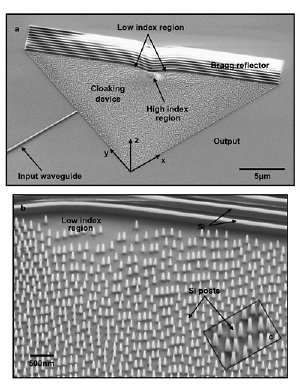May 12 2009
Somewhat the way Harry Potter can cover himself with a cloak and become invisible, Cornell researchers have developed a device that can make it seem that a bump in a carpet -- or, indeed, any flat surface -- isn't there.
 Scanning electron microscope images of the cloaking device. Top: Light passes through silicon posts as it bounces off a deformed reflector. Varying density of the silicon posts bends light to compensate for the distortion in the reflector. Bottom: a close-up of the array of silicon posts, each about 50 billionths of a meter in diameter. Provided/Nanophotonics Group
Scanning electron microscope images of the cloaking device. Top: Light passes through silicon posts as it bounces off a deformed reflector. Varying density of the silicon posts bends light to compensate for the distortion in the reflector. Bottom: a close-up of the array of silicon posts, each about 50 billionths of a meter in diameter. Provided/Nanophotonics Group
So far the illusion works only at the nanoscale, but the researchers suggest that the basic principle might eventually be scaled up for military and communications applications, or perhaps used in reverse to concentrate solar energy.
Devices that bend microwaves around small objects have previously been demonstrated, but this is the first cloaking device to work at optical frequencies, the researchers said.
The experimental device was built by Michal Lipson, associate professor of electrical and computer engineering, and colleagues in her Nanophotonics Research Group, based on a design by British physicists. It bends light bouncing off a reflective surface in a way that corrects for the distortion caused by a bump in the surface. Imagine controlling the light in front of a funhouse mirror so that reflections look perfectly normal, and the mirror looks flat.
A similar device that works at one particular wavelength of infrared light has been reported by University of California-Berkeley researchers, but the Cornell device is expected to work over a range of wavelengths from infrared into visible red light, the researchers said.
On a silicon wafer, Lipson's group made a tiny reflector about 30 microns (millionths of a meter) long with a 5-micron-wide bump in the middle, then placed an array of vertical silicon posts, each 50 nanometers (billionths of a meter) in diameter, in front of it. Because the posts are much smaller than the wavelength of the light, the light behaves as if it were passing through a solid whose density varies with the density of the posts. As light passes between regions of high and low density it is refracted, or bent, in the same way light is refracted as it passes from air to glass. By designing smooth transitions of the density of posts, the researchers could control the path of the light to compensate for the distortion caused by the bump.
As a result, an observer looking at light reflected from the mirror sees a flat mirror, with no sign of the bump.
Of course it's still a long way to cloaking tanks on a battlefield. For starters, the thing being hidden has to hide behind a mirror, and the presence of a mirror would be a giveaway. A practical cloaking device also would have to adjust in real time to changing configurations of the object behind it.
A variation of the method might be used to bend light around an object, the researchers suggested, and a light-bending device could be made much larger by using technology that stamps or molds nanoscale patterns onto a surface.
Such refraction control might also be used in reverse, they added, to concentrate light in a small area to efficiently collect solar energy.
"At the core is the fact that we're manipulating light, telling it where to go and how to behave," said Carl Poitras, a research associate on the Cornell team.
The device was manufactured at the Cornell Nanoscale Facility, which is supported by the National Science Foundation.